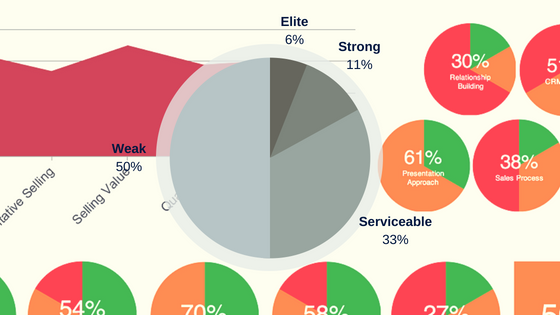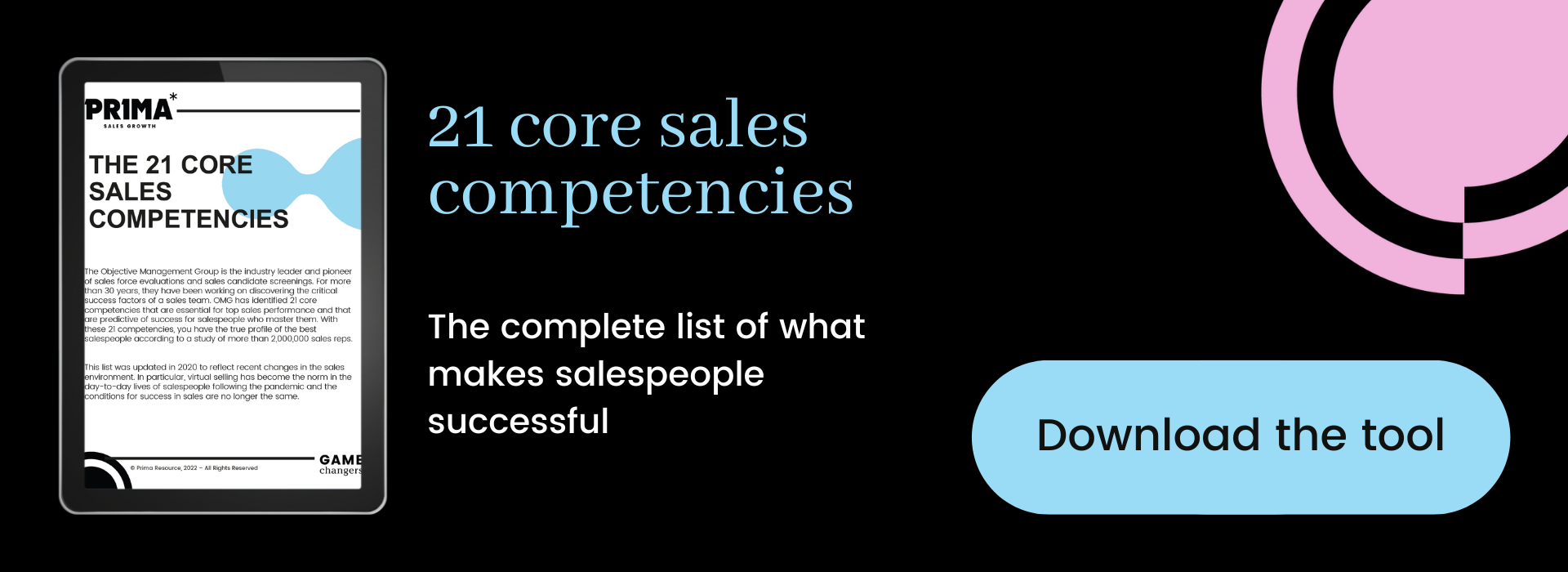
How do you get a general overview of a sales representative’s skills?
The Sales Percentile, developed by Objective Management Group is the single best measure available.
Previously known as the Sales Quotient, OMG updated the finding to give managers a more concrete idea of the skills and competencies of a representative with his/her peers.
Let me explain the relevance of this substitution.
What’s the difference between the Sales Quotient and Sales Percentile?
Essentially, both are very similar :
Both represent an accurate, reliable and predictive indicator that gives the best overview of a representative and, therefore, of the entire sales team;
They are based on the same 21 key sales competencies.
The difference lies in their rating scale. The Sales Quotient ranged from 0 to 173, while the Sales Percentile ranges from 0 to 100.
It is this adoption of a more natural comparison that justifies the evolution towards the Sales Percentile.
An assessment on a scale of 0 to 100 is much easier to understand: in everyday life, almost everything is assessed as a percentage. As early as elementary school, we are taught to recognize our success with our group on a scale from 0 to 100.
The Sales Percentile thus gives a better understanding of a representative’s abilities and allows a sales leader to situate him or her better within a group, whether it be the company’s own sales force or all the representatives evaluated by OMG.
It is easy to understand, for example, that a representative with a 90 percentile is better than 90% of the other representatives assessed but worse than 10% of them. With the Sales Quotient, a score of 155 out of 173 was much less concrete because it did not correspond to any known reference.
How is the Sales Percentile measured?
With the Objective Management Group evaluation, approximately 250 factors are analyzed to obtain the Sales Percentile. When I have to choose a single measure to describe a salesperson, I use the Sales Percentile.
It is measured on a scale from 0 to 100, the latter being the perfect score. Within this scale, representatives are placed into four distinct categories based on their score.
Statistically, compared to the old Sales Quotient, the Sales Percentile changes the proportion of reps within each category. Concretely, here is what the groups now look like.

- Elite salespeople score between 95% and 100%, representing 6% of the sales force.
- Strong salespeople score between 84% and 94%, representing 11% of the sales force.
- Serviceable salespeople score between 51% and 83%, representing 33% of the sales force.
- Weak salespeople score between 0% and 50%, representing 50% of the sales force.
Dividing representatives into categories makes reading and understanding the results clear, simple, visual and tangible. The analysis of a group of representatives is thus greatly facilitated.
These statistics are based on the evaluation of nearly 2 million representatives and are therefore the most predictive tool on the market.
Why use the Sales Percentile?
Recruit Good Salespeople
When recruiting, we generally target candidates who have a Sales Percentile between 51 and 100 because they have a serviceable, strong or elite level of competence.
Some companies may only need elite salespeople, i.e. with a Sales Percentile of at least 95, but this depends on the specifics of their sales environment. To define if a company needs this sales profile, we use a list of 30 criteria. The combination of the answers makes it possible to know which category of representative to target.
The Sales Percentile also impacts the retention and longevity of representatives (i.e. the length of time the individual is likely to remain in the business). The data shows that salespeople with Sales Percentiles of 95 and higher tend to stay less in at a company longer.
Know Your Representatives’ Score
When we do a sales force evaluation, one of the steps is to assess each team member individually in their role.
The goal of evaluating teams before training or coaching is to understand each’s strengths and weaknesses accurately. Without this, it is impossible to address the real causes of the low sales performance.
For example, if a company has difficulty winning new customers, generally it is not because the representatives have a weak Closer Competency score. Yet, sales leaders often seek to address this problem through sales closing training.
The Sales Percentile is therefore used to work on developing the right skills and prevent weak Sales DNA from sabotaging sales efforts.
Takeaway
OMG has made this change following many other improvements to its products over the years. With each move, we have adapted to optimize our evaluation techniques, and this evolution is no exception.
With the Sales Percentile of your representatives, you have a complete record of their capabilities, and you can thus have an unequalled level of precision in the deep understanding of your team. Once you have this information in hand, your sales management, coaching and development efforts are facilitated by the quality of the information at your disposal.
In my opinion, this scale of measurement is so concrete and straightforward that it represents a logical evolution… 100%!






